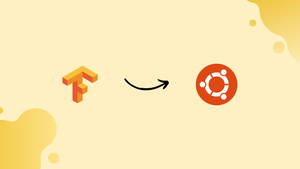Choose a different version or distribution
Introduction
Before we begin talking about how to install TensorFlow on Ubuntu 22.04, let's briefly understand – What is TensorFlow?
TensorFlow is a powerful open-source machine learning framework developed by Google. It enables developers and researchers to build and train machine learning models efficiently. With its extensive library of pre-built algorithms and tools, TensorFlow simplifies the process of creating intelligent applications.
Its flexibility and scalability make it suitable for various applications, such as image and speech recognition, natural language processing, and predictive analysis. By providing a user-friendly interface, TensorFlow empowers individuals and businesses to harness the potential of machine learning and drive innovation in diverse fields.
In this tutorial, we will describe how to install TensorFlow on Ubuntu 22.04. We will also address a few FAQs on how to install TensorFlow on Ubuntu 22.04.
Advantages of TensorFlow
- Powerful: TensorFlow is a robust framework that offers high-performance computation for complex machine learning tasks.
- Versatile: It supports a wide range of applications, including computer vision, natural language processing, and predictive analytics.
- Scalable: TensorFlow can seamlessly handle both small and large-scale projects, making it ideal for industrial applications and research.
- Extensive Community: It benefits from a large and active community, providing support, resources, and a wealth of pre-trained models.
- User-Friendly: TensorFlow offers an intuitive and flexible interface, making it accessible to both beginners and experts in machine learning.
Install TensorFlow on Ubuntu 22.04
Step-by-step instructions are provided in the following sections for installing TensorFlow in a Python virtual environment on Ubuntu 22.04.
1) Installing Python 3 and venv
First, use the following command on Ubuntu 22.04 to confirm that you have the most recent version of Python3 installed:
python3 --version
The output should look like this:
Output
Python 3.10.4
The venv module should be used to establish a virtual environment starting with Python 3.10. Run the following command to install the python3-venv package, which contains the venv module:
sudo apt install python3-venv python3-dev
We are now prepared to build a virtual environment for our TensorFlow project once the module has been deployed.
2. Creating a Virtual Environment
Navigate to the directory where you want to keep your Python3 virtual environments to get started. Your home directory or any other directory with reading and write rights for your user might serve as the source.
For the TensorFlow project, create a new directory and cd there:
mkdir my_tensorflow
cd my_tensorflow
Run the following command to build the virtual environment once you are inside the directory:
python3 -m venv venv
A copy of the Python binary, the Pip package manager, the default Python library, and other supporting files are all created in the directory venv by the aforementioned command. For the virtual environment, you are free to choose any name.
You must execute the activate script in order to activate this virtual environment before you can use it:
source venv/bin/activate
The bin directory for the virtual environment will be added to the $PATH variable after it is launched. Additionally, the prompt for your shell will alter and display the name of the virtual environment you are now using. That is venv in this instance.
Pip version 19 or later is required for TensorFlow installation. To get the most recent version of pip, do the following command:
pip install --upgrade pip
3. Installing TensorFlow
The TensorFlow package has to be installed now that the virtual environment is active.
pip install --upgrade tensorflow
--no-cache flagUse the command that prints the TensorFlow version to confirm the installation:
python -c 'import tensorflow as tf; print(tf.__version__)'
At the time of writing this article, the latest stable version of TensorFlow is 2.8.0
Output
2.8.0
TensorFlow may have changed from the version seen here.
Visit the Get Started with TensorFlow page to discover how to create your first machine learning application if you are new to TensorFlow. To explore and test the TensorFlow examples, you may also clone the TensorFlow Models or TensorFlow-Examples repositories from GitHub.
When you're finished, type deactivates to turn off the environment and go back to your default shell.
deactivate
Removing TensorFlow from Ubuntu 22.04
You will need the following command to completely remove TensorFlow from Ubuntu 22.04, which will delete all relevant TensorFlow files from Ubuntu 22.04.
sudo python3 -m pip uninstall tensorflow
FAQs to Install TensorFlow on Ubuntu 22.04
What are the system requirements for installing TensorFlow on Ubuntu 22.04?
TensorFlow requires a 64-bit operating system, a minimum of 4GB RAM, and a CPU with support for AVX instructions.
Do I need to install Python before installing TensorFlow?
Yes, TensorFlow requires Python. Ensure that you have Python installed on your Ubuntu 22.04 system before installing TensorFlow.
Can I install TensorFlow with GPU support on Ubuntu 22.04?
Yes, you can install TensorFlow with GPU support on Ubuntu 22.04. However, you'll need to have a compatible NVIDIA GPU and install the necessary CUDA and cuDNN libraries.
What version of TensorFlow should I install on Ubuntu 22.04?
The version of TensorFlow you should install depends on your requirements. You can choose between the stable version or the nightly build for the latest features.
Are there any additional packages or dependencies needed for TensorFlow installation on Ubuntu 22.04?
TensorFlow requires several dependencies, such as numpy, wheel, and six. The installation process will automatically handle these dependencies.
How can I verify if TensorFlow is installed correctly on Ubuntu 22.04?
You can open a Python interpreter, import TensorFlow, and check for any errors. Alternatively, you can run a simple TensorFlow program to verify its functionality.
Can I create a virtual environment for TensorFlow on Ubuntu 22.04?
Yes, it is recommended to create a virtual environment to isolate TensorFlow and its dependencies from your system's Python environment.
Conclusion
We have shown how to install TensorFlow on Ubuntu 22.04 in this tutorial.
If you have any queries, please leave a comment below, and we’ll be happy to respond to them.
